
Therapy dog Circe (left) often joins Yockey for sandplay sessions.
In the spring of 1997, licensed clinical social worker Shannon Yockey was attending a play therapy conference in California when she stumbled into sandplay. Yockey found herself in a small, crowded room, watching a diminutive Catholic nun give a slide presentation on the modality. “It just really captured me,” Yockey said. Twenty-five years later, Yockey has not only become a certified sandplay therapist but has also completed her training as a Jungian analyst. Speaking from her home office, with Carl Jung’s collected works lining one wall, and shelves piled with figurines in the background, she explained how sandplay allows both children and adults to heal old trauma and explore their deeper selves.
Editor’s note: This interview has been edited for length and clarity.
What is sandplay?
Sandplay is a form of Jungian depth work that employs large trays to create scenes and images using sand, water and a variety of figures. It was developed by a woman named Dora Kalff – I actually had a chance to go to a sand play intensive session seven years ago and to visit her sand room. Kalff was a student of Carl Jung’s. And when Jung was having trouble moving through a difficult time, he recalled that when he was a child he would build little structures on the lakeshore. So he decided to revisit the practice as an adult, and found that it opened things up for him.
Kalff trained with a woman named Margaret Lowenfeld in London, who was using multiple counselors moving around a room and working with various children doing sandplay. Kalff recognized the importance of the individual relationship between the sandplay therapist and the child, so that was the difference in her approach. Buddhism was also a big part of her life, so she was influenced by mindfulness in addition to depth psychology. Rather than Lowenfeld’s structured, multi-counselor environment, Kalff aimed for the creation of a safe and protected space. Our training is really in being the silent witness, knowing that the medicine is really that holding container, as well as the client’s experience with the symbols.
Depth psychology is really about realizing that the painful situation is like Ariadne’s thread – it will take you someplace deeper. You will likely experience symptom relief, but more than that, you’ll have an encounter with yourself. It has a very transpersonal aspect that is helpful when people are facing critical issues in their lives. One of Jung’s quotes that sandplay therapy rests on is: “Often the hands will solve a mystery that the intellect has struggled with in vain.”
Why were you so drawn to sandplay?
I became a Catholic when I was in high school because there was something about the rituals during mass – the incense, and the iconography – that pulled me in. I’ve always loved the nuns; they’re the best part of the church, most of the time. When I attended the play conference, I was still a practicing Catholic, and the archetypal imagery, the movement in the sand, and the way the nun was holding the sacredness had such a soul resonance for me.

Yockey’s sandplay collection includes natural and man made objects, as well as representations of deities or supernatural beings.
How long does a sandplay process typically take?
It’s so varied. It can be anywhere from a few to 40 trays. If you’re a therapist wanting to get trained and become certified in sandplay, the society’s recommendation is 30 trays in 40 sessions.
The first one to three trays typically show what the journey is going to look like – some of the difficulties the person is going through, as well as some of the allies and resources that they have. The rest of the process explores that further. At the end, there’s usually a sort of consolidation tray; what they’ve been through and where they’re headed.
Can somebody do sandplay on their own? Why is the witness important?
I don’t know a sandplay therapist who doesn’t; I’ll occasionally do a sand tray at the end of the day. Some of that is natural. People go to the beach and make designs in the sand. There are a lot of ancient practices that are similar: Navajo sand paintings, Tibetan sand mandalas. It’s important for people to have their own rituals and creative processes, like when Jung went to the lakeside to create.
But there’s something about having a witness that’s significant. Kids often want their parents to see what they’ve made. Typically, I’ve already done a pre-session with the parents and advised them to not make any comments about the tray, because they can be put off or concerned by the darker elements. Whatever the psyche’s bringing forth is what needs to be brought forth, without filtering, and it’s important that the witness is there to hold it.
Some of the trays are devastating. I once had a child who’d been an in vitro baby and three of her siblings had been aborted so that she could survive. She formed an image of that in the sand and had a story about it. Of course she didn’t say that she had siblings who were aborted, exactly, but she would see three children with their mouths sewn closed trying to talk to her, so this was existing in her unconscious and she was trying to make sense of it. I wasn’t sure what I was seeing, but it was so disturbing. And when I followed up with the parents and asked what had happened prenatally, that’s when the story came out. There’s no way that she could have gone through that process with a parent.
What kind of clients do you work with?
My interest is in helping people to connect to their deep center and deep psyche and find meaning. So I tend to work with people with trauma, complex developmental trauma, and grief. I’ve worked with a few children who’ve lost parents to suicide, and people at different stages of grief. I also work with therapists who want to get certified.
For the first 15 to 18 years of my professional life, I worked mostly with children and teenagers. With children, we were typically working on anxiety or trauma, including sex abuse. I’d give them an introduction, show them some pictures, and say: “Would you like to create a sand picture?” Every child says “yes.” So I let them know, “There are only two rules in the sand room: we don’t hurt the toys and we don’t hurt each other.” Everyone respects that – sometimes kids will knock toys down, but that’s part of the therapy. Then I invite them to choose whatever figures they’d like from the shelves; I have everything from rocks, trees, and animals to deities from different religions, representations of the elements, and monsters. I have tools for the sand, and some kids pour water into their trays. The tray size is designed to be contained within your field of vision, and the bottom is always blue, so they can also create little furrows for water features. Most kids want to play, and sometimes they want me to play with them. Sometimes they’ll give me direction, or sometimes I’ll build another sand tray that mirrors what they’re building.

One of Yockey’s sand trays pictures a scene with animals, trees and water.
In the last 10 years, I’ve worked mostly with adults – occasionally, they’ll connect with their inner child and become excited, but most are a little reluctant to engage. Sometimes I’m doing EMDR and people get stuck in their processing, so I’ll invite them to do a sand picture. Even just one or two experiences can really move things, because when they open up to the sand, they’re opening up to the unconscious and the transpersonal part of the psyche. Adults can end up feeling very vulnerable and exposed, because they typically pick things that are representative of what’s happening in their lives but aren’t initially aware of that.
Then, I’ll ask them if there’s any story that comes with the sand picture, or if there’s anything they want to share; I don’t do any interpretation. Children often have stories. Sometimes adults want to talk, and sometimes they don’t. Sometimes you can feel that they’re having a numinous experience – the hairs on your arms stand up, and you can almost come to tears. So words and dialogue can actually detract from that. When the session ends, they leave the image intact – they don’t dismantle it themselves – and I’ll photograph it from different angles. Sometimes after everything’s been lifted out of the sand tray there are remarkable designs or imprints, and I’ll photograph those as well. Once someone has finished the process, I’ll suggest that they return a year later and show them a PowerPoint with all their images. It’s very moving to see your sandplay process; it helps you understand what you went through and where you’re at now.
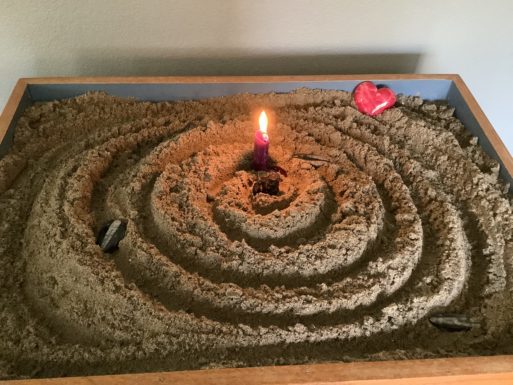
One of Yockey’s personally created sand trays.
In what ways is sandplay effective?
Sandplay provides an opportunity to express what’s happening without necessarily having the words for it. This is especially important for children, who until they’re teenagers aren’t developmentally able to do so – it’s hard enough as an adult. And I’ve never had an adult, myself included, who doesn’t have a profound experience with the sand because it connects to something deeper than words. For example, I was talking to a woman yesterday who’s really suffering as a caregiver to her husband and feeling so much guilt around it. She was able to share that in a way, and not have to hold that herself.
Someone can also have what we call a shadow confrontation, dealing with those parts of themselves that have been split off or rejected. And then there’s a consolidation – like okay, I have these parts, maybe they’re not so bad – which leads to an experience of wholeness.
Jung lived through World War I, World War II, the Great Depression, the Spanish Flu, and nuclear proliferation. So his psychology, which draws on others’ before him, was born out of times of great turmoil. His main call to us was to understand our shadow pieces so that we’re not projecting them out and creating havoc in the world. Jungian depth work is asking us to come into contact with these very difficult aspects of ourselves. Sometimes it’s the golden shadow, where something positive was suppressed — such as women’s ability to express their authentic voices, their knowing, their wisdom.
What does individuation mean to you, and how does sandplay therapy contribute to individuation?
I see individuation as the little acorn where, given the proper conditions, it has everything it needs to become a full-grown oak tree. Because of life trauma or difficulties we can, like a tree, get bent over so that we can survive the storms. Individuation is the striving for wholeness and balance in the personality by connecting with the dark and light aspects of ourselves, so that we don’t reject any of them. It’s becoming who you’re meant to be, which is no small task.
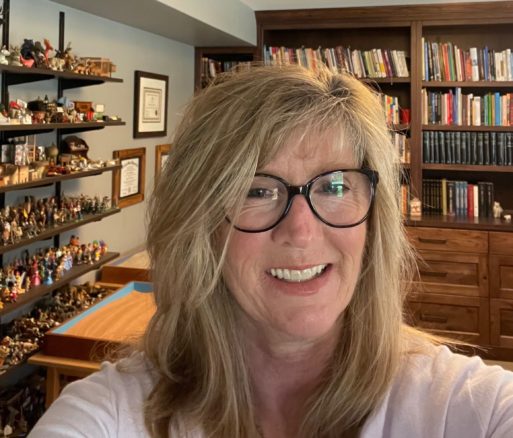
Yockey in her home office, with a sand tray, figures, and Jung’s collected works in the background.
What did you personally learn through engaging in the sandplay process?
If you want to become certified it’s a multi-year process: you do your own deep work in the sand, and then you do supervision, and casework, and write papers. There was a sandplay therapist about an hour from my home that I worked with. I was going through infertility at the time, and it’s just so painful when you can’t realize such a deep desire. So what was so powerful about my experience was recognizing the pain of it, but also being held in it by something greater than both the therapist and myself. It was a different experience of the divine.
After finishing the first part of my process, I took some time off, and interestingly I became pregnant shortly after. Often our trauma gets stored in the body and can cause physiological issues or illness. I believe that there was trauma in my life that hadn’t been resolved and that contributed to my inability to get pregnant, and that it got worked out through sandplay. Does that mean that if someone doesn’t get pregnant they didn’t work on their trauma? No. That was just my particular path. But I’ve seen those kinds of things happen for people – hurts that never seemed to heal, or connections to self, or to something greater than oneself, that were inaccessible before working symbolically.
That experience was what sparked my interest in Jungian studies, which awakened my connection to the natural world and inspired me to help others to connect as well. Nature has everything that we need to find meaning, to experience incredible healing and wholeness. I’ve seen unbelievable things happen in someone’s backyard.
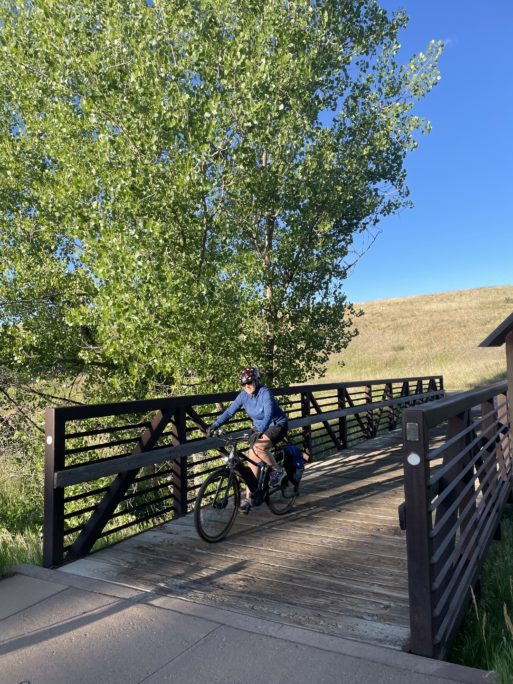
Yockey enjoys the natural world on a bike ride in Colorado.
Can you give me some examples?
I was with a woman in my office many years ago; she was asking me for advice about a relationship and I had nothing to give her. And it was just quiet in the room. At that particular moment a kestrel, which is a little hawk, landed on my bird feeder and looked penetratingly into the office at both of us. It was this numinous moment; you could feel that something was happening. It lasted maybe 30 seconds, but it took both of our breaths away. I’ve never had a kestrel come to my office before, and never since.
So we spent some time looking at the kestrel, and its behaviors, and it’s the only little raptor that hovers. My client recognized that she wanted to rush a decision about the relationship when she needed to have some hovering time. By not making an immediate commitment either way, her partner kind of showed himself and she decided not to stay in that relationship.
I worked with another woman for years who was in great suffering because of her psychiatric diagnosis, and didn’t know if she’d take her life. I have a vase of beautiful peacock feathers, and one day, the peacock feathers kept coming into my face, and I kept batting them away. All of a sudden I had a reverie of a time when I’d had an office fire and I lost my first sandplay collection along with some things important to my identity and my marriage. During that time, the peacock emerged as a symbol in my own symbol study. Mythologically, the peacock’s known for being able to ingest poison and transmute it into medicine. So I started to share this with her, and all of a sudden something shifted – she sensed that if she continued to endure what she was suffering, perhaps it could somehow transmute. Then, about an hour after the session, I got a phone message from her. She said, “Shannon, you’re never going to believe this, but I was on my way home and saw peacocks on the corner lot of my neighborhood. I’ve never seen them there before.” So she had this synchronistic experience of something greater than her. And she said, “I’m still hurting, but I have hope.”
How can sandplay be helpful in addressing issues around terminal illness and end of life?
Those kinds of experiences happen on steroids with someone who’s facing a terminal diagnosis. When death is approaching, all of a sudden the worlds are not so separate, because you’re preparing for whatever’s next.
I’ve found that when somebody has a serious illness or is facing their death, they want to know: Does it matter that I was here? So then it’s about creating a space where they can connect into some messages they may have received that they weren’t important or that there was something wrong with them. Often, it’s about healing the relationship with themselves so that they can connect with the more divine, transpersonal realm. Working symbolically opens up more access to that realm – and it can also mean working with dreams, artwork, or even songs.
I’ve had children who’ve lost parents to suicide, and there’s just tremendous grief. And so in the sand they can create volcanoes, they can create whole worlds, they can put sand everywhere. In one scene they can show anger, despair and grief, and also an animal and its mother going off into the sunset. So much can be expressed, and all without words.
The sandplay images, just like dream images, are really windows into the soul. When a dream happens to you, it comes from the unconscious. But when you’re co-creating and opening up to what the transpersonal and the unconscious has to offer, it’s a kind of magic. It gives people hope.
Is there a final thought you’d like to end with?
Sandplay is such a beautiful experience – it can feel incredibly vulnerable, but can also be so supportive.

 Sandplay Therapy: Reading the Symbols in the Sand
Sandplay Therapy: Reading the Symbols in the Sand

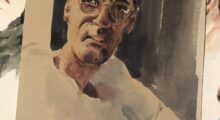
 Some Fathers Golf, Mine Painted Nudes
Some Fathers Golf, Mine Painted Nudes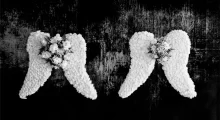
 “Soul With Me” by DePeche Mode
“Soul With Me” by DePeche Mode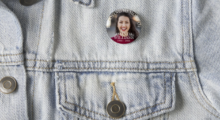
 Our Monthly Tip: Make A Keepsake Pin to Honor Your Loved One
Our Monthly Tip: Make A Keepsake Pin to Honor Your Loved One














